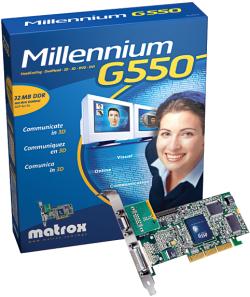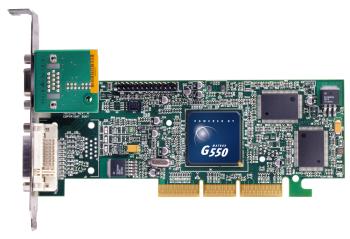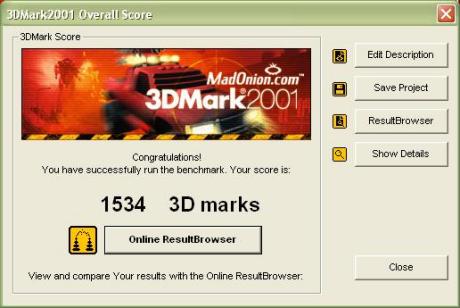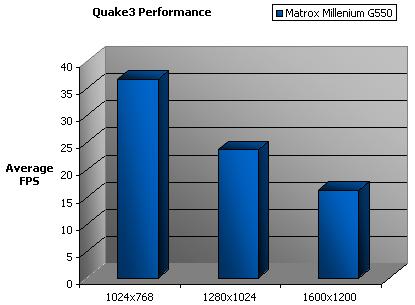|
 
Introduction
Anyone monitoring the current consumer graphics market, especially in relation to gaming and 3D performance will notice that Matrox haven't been a large player in that particular market for a while. However that hasn't stopped them making cards and they continue to develop new products and enhance the products they already have.
The Matrox of today has a different focus from the NVIDIA's and ATi's of this world. They aren't out to create the fastest gaming accelerator and have no cards to compete in that sector at the moment. Instead, they have tailored their newest solution to a different market altogether. The Millenium G550 which I'm looking at today is aimed squarely at the business user.
Before we analyse the card and its performance and features, lets take a look at the technology that makes up the G550 core.
Chip Specification and Technology
We'll take a formal look at the specification shortly. First off, a quick look at the highlights and features that most people identify with. The core itself is created on a 0.18 micron process and has a 256-bit wide data path internally and a 64-bit external DDR bus to the frame buffer. It has the maximum compliment of 32Mb of memory, the most the chip supports and full support for AGP4X and bus mastering.
Lets take a look at the formal specification.
- 0.18 micron, 256-bit DualBus architecture
- 64-bit DDR path to 32Mb of framebuffer memory
- Full AGP4X support (1X, 2X and 4X supported fully)
- Dual integrated RAMDAC's (360Mhz primary, 230Mhz secondary)
- Dual integrated TMDS transmitters for dual display to digital flat panels
- Integrated TV encoder
- Matrox DualHead Technology
- HeadCasting Engine
- Dual pixel pipelines with 2 texturing units per pipeline
- High quality DVD and digital video playback using DVDMax
- Vibrant Colour Quality 2 Rendering
- UltraSharp RAMDAC technology
- DirectX Environment Mapped Bump Mapping
- Bilinear, Trilinear and Anisotropic Filtering
- 32-bit Z-buffer and 8-bit Stencil
So at first glance, we have a competent 3D accelerator with a few interesting twists. If you notice, the G550 has the latest implementation of Matrox's DualHead technology. In the G550 incarnation, the DualHead technology is taken to the next step. The card supports dual display on a wide combination of output devices. On the version tested, the card has a regular 15-pin D-SUB connector and a seconday DVI connector and versions exist with dual DVI connectors for hooking up 2 digital flat panels or 2 digital monitors.
However on the test version of the card, the 15-pin D-SUB is driven by the primary DAC and only analogue RGB monitors (including analogue flat panels) can be connected to that port. The DVI port takes care of connection to a DVI capable flat panel or digital monitor (adaptor supplied). A TV-out cable is also provided which also hooks up to the primary DAC 15-pin D-SUB and gives S-Video or composite video output. The cable has two outputs.
This configuration only lets you use DualHead with TV-Out when you have a digital device connected to the DVI port. Therefore in my case, with an analogue monitor (Sony G400) hooked up to the primary DAC, the TV-Out functionality is lost and technologies like DVDMax are unusable, where you run Windows on the primary display and a digital video source such a DVD on the second head (TV-Out).

HeadCasting
I'm in two minds about HeadCasting. For me, personally, the technology is useless and redundant. However, for business users willing to invest in the technology, it does have benefits. HeadCasting is a technology supported by the G550 processor that animates a fully 3D, skinned, talking head. You use a technology and software application called DigiMask. Created by the company of the same name, DigiMask software lets you create an accurate 3D model of a persons head using software bundled with the card. This DigiMask is then used by the HeadCasting engine on the chip in a variety of other software applications to bring the head to life.
The first piece of bundled software is called HeadFone, licensed from LIPSinc. The application functions like an instant messaging program but instead of text, you see the HeadCasting accelerated 3D head talking to you. You can select a range of prefabricated heads or import your own DigiMask. Using speech recognition, the HeadCasting engine syncs the 3D head to your speech, giving the impression of authentic facial animations. The G550 makes use of its vertex and pallete skinning engine to support hardware skinning and vertex shading for supposedly phot realistic heads.
HeadFone is the application I can see businesses making most use of for site to site communcations. It requires a PC with a G550 accelerator at each and and the required audio hardware for speaking. The software transmits the HeadCasting data back and forth over the network and the HeadFone software animates the talking head at the other end using the HeadCasting engine on the G550.
The next piece of software that just escapes being branded as having novelty value only is the Matrox Virtual Presenter for Microsoft Powerpoint. Again, it uses LIPSinc TalkBack technology to embed a HeadCasting accelerated talking head in a PowerPoint presentation (2000 and XP versions supported). The head is animated according to narrated audio. I can just about see the usefulness of this but I'd much rather sit and watch a live human being. By it's very nature, a single animated head can't convey the same range of emotion and information you get from watching a real person. Accompanied by the narrator maybe but if the narrator is present, what's the use for the HeadCast? Again you can import your own DigiMask from the DigiMast software or use a prefab head.
To conclude, HeadCasting, for me anyway has no use outside a business environment and wherever I've encountered a business incident where the technology could be employed, more established, effective means of communication are present. Video conferencing works fine and you get a more human interaction. For sure, HeadCasting is an interesting technology and we can applaud Matrox for taking the first steps to bring such a technology to the masses, it just doesn't have the features or 'realness' to work properly and I can't envision a good business fit. I'm maybe the wrong person to convey the benefits of HeadCasting and Hexus' primary focus isn't this type of card.
DVD playback
Matrox deserves som credit for it's DVD playback solutions with the G550. The underlying hardware is a highly capable DVD playback solution and the software layered on top is excellent. DVDMax is part of the DualHead technology and allows full screen, full speed digital video playback on the 2nd head. This isn't limited to playing DVD's through Matrox's DVD player software. DVDMax picks up the use of Windows Media player and other applications capable of playing digital video, be it DVD content, AVI's or other video streams and scales and accelerates on the 2nd head. Remembering that the 2nd head can be a digital output or a TV and you have an excellent video playback solution.
The hardware isn't as competant as a Radeon (any guise) since the hardware doesn't do iDCT in hardware, a function that helps along DVD playback immensely, but is a match for an NVIDIA card for sure.
3D Performance
While we aren't going to run the usual full gamut of test benchmark software on the G550 simply because it's not a gamers card, it may be called on at time to do some 3D work, although we don't recommend it for high speed, full featured 3D rendering. Lets take a peek under the hood and see what hardware the card has 3D wise.
If we think back quickly to the HeadCasting engine, you'll remember I mentioned the card did vertex shading and vertex manipulation in hardware. While it's nothing like the full Vertex and Pixel Shader implementations in a GeForce3 or Radeon 8500 it does do some key operations.
The card does do the full Programmable Vertex Shader spec in DirectX 8.0 in hardware, just it isn't anywhere near the speed of ATi or NVIDIA's solutions. It has 256 constant registers to allow it to do a full 32 matrix skin of a 3D mesh in hardware. It does Matrix Pallete Skinning (part of the DX8 spec) in hardware with up to 32 matrices and splits things up per vertex, per triangle or per draw, depending on what needs to be done. This lets the card do realistic facial animations and other operations which call upon the MPS functionality.
Being a relatively new part, the card also has hardware support for the major D3D and OpenGL primitive formats and is a full 32-bit renderer along the entire pipeline including 32-bit multitexture and final 32-bit colour output. Basically the hardware supports a full triangle setup and acceleration engine and up to date rendering features just it's not as quick as any recent hardware as we'll find out.
Before we take a look at the 3D performance using 3DMark 2001 Profession and Quake3, here's the test system.
- Matrox Millenium G500 32Mb AGP DualHead
- Soyo Dragon Plus KT266A Motherboard
- AMD Athlon XP1800 Processor
- 256Mb Crucial PC2100 CAS2.5 DDR memory @ CAS2
- Adaptec 39160 PCI SCSI Dual Channel U160 controller
- 2 x 73Gb Seagate Cheetah U160 10,000rpm SCSI disks
- Plextor 12/10/32S SCSI CDRW
- Soundblaster Audigy
- Windows XP Professional Build 2600.xpclient.010817-1148
- Revision 5.82.014 of Matrox Powerdesk Drivers for Windows 2000/XP
- Quake3 v1.30
- 3DMark 2001 Professional
First of all, 3DMark. Remember this is a DirectX 8.0 compliant benchmark and makes full use of the Pixel and Vertex Shader spec in DirectX 8.0. The hardware doesn't run the Nature test due to a lack of hardware acceleration for the features the test needs.

I recently reviewed the Gainward GeForce3 Ti550 on the same base platform, all that has changed is the graphics card. The Gainward scored 7810 3DMarks or nearly exactly 5 times the score of the Matrox. This isn't intended to embarass the Matrox in anyway, it purely serves to highlight that the G550 is not a gamers card. You can see that the features on the card endear it to a much different market than one that would purchase a GeForce3.
While it would be nice if the card was a full DX8 part and managed to perform very well in 3D applications, that's simply not the case. The cards strengths lie elsewhere.
Finally, we'll take a quick look at the OpenGL performance of the card using Quake3.

Performance even at 1024x768 is unacceptable for comfortable gameplay and a lower resolution would benefit the card a lot more. Remember that the Quake3 benchmarks we do at Hexus are with all performance sapping rendering features turned on. The card struggles playing Quake3 with everything on and the Gainward Ti550 ends up being over 8 times faster at 1600x1200. We can see that gaming is not the cards strong point at all sadly.
Again, it's obvious that the cards strengths lie elsewhere and that gaming isn't really acceptable, not with current titles at least, even with a highly capable AthlonXP platform to work with. The system would still be card limited even on an XP1500 or lower.
Conclusion
So, we've seen that the G550 is not a gamers card. That's fairly obvious. Taking a look back at the feature list we can see that the card is targetted elsewhere. Matrox has never made anything of the G550 being a gamers card and have targetted at graphics professionals needing exceptional 2D image quality or the dual head capability.
Matrox is known for it's incredible 2D image quality on earlier products. For example, back in the days of the Voodoo2, the G200 Millenium was the 2D card of choice (remember, the V2 was a 3D pass through renderer and needed a 2D card) to pair with a pair of 12Mb Voodoo2's in SLI. The G400 was also a class leader in 2D performance and the G400 MAX DualHead was a fine card back when it was released. DualHead was still a novelty then and Matrox pulled it off very well and gave the masses a twin output solution.
Times have changed however. Coming back to the 2D aspect, while the card has excellent 2D image quality on the primary head due to the 360Mhz RAMDAC, it's in my opinion no better than the 2D performance of any of ATi's recent cards (7500 or 8500) and is even matched by some NVIDIA cards in 2D performance. NVIDIA cards aren't famed for excellent 2D image quality but recent cards, especially from Gainward and to some extend Leadtek have had very good 2D image quality at high resolution. The G550 isn't a step ahead of the rest any more when it comes to the 2D image quality.
DualHead is also not a novelty any more. NVIDIA have their TwinView solution, most commonly found on GeForce2 MX cards and ATi have HydraVision, present on the 7500 and 8500 cards. Matrox arguably pull it off better than the rest with DVDMax especially standing out as a great feature on the G550 (also present on the older G400), HydraVision from ATi is a good solution and is present on a lot of their cards. While I haven't sampled a TwinView card, I do know first hand that HydraVision on the ATi performs excellently.
Therefore it seems that Matrox doesn't really have much to show with the G550. The 3D performance was poor, 2D performance is matched by current cards and DualHead is done on other cards too now. The card definitely has a place in the market as a niche product and the HeadCasting technology does have a use, albeit fairly limited, in business applications and is something Matrox should persue. It's just not a gamers card sadly but will no doubt appeal to some of you for the other features. DVDMax is a fairly compelling reason to pick up a G550 cheaply for use on a dedicated DVD PC if you can find one.
Matrox, in the product literature we recieved with our press sample, pits the card directly against a Radeon VE and GeForce2 MX. Both cards do a twin output solution and both are faster at 3D, the GF2 markedly so. Price wise, all of the cards compete in the sub £100 bracket making them cheap to acquire if their features match your needs. Just remember that it's not a gaming card.
Hopefully we'll see Matrox back soon with new card since one less player in the performance card market means less competition which only harms the consumer.
|